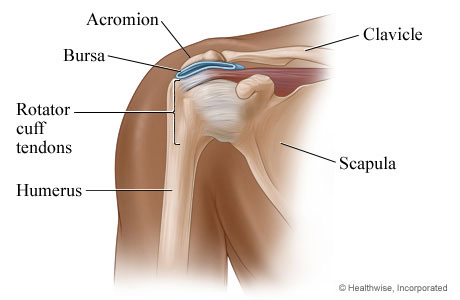Jump to
Bursitis of the Shoulder

Bursitis of the shoulder is inflammation of the bursa found between the bone at the top of the shoulder (the acromion), the upper arm bone (humerus), and the tendons and muscles.
A bursa is a fluid-filled sac that cushions and lubricates areas of the body where friction is likely to occur. Examples of such areas include between two bones, between a tendon or ligament and a bone, or between bone and skin.
How can you care for yourself when you have shoulder bursitis?
- Put ice or a cold pack on your shoulder for 10 to 20 minutes at a time. Put a thin cloth between the ice and your skin.
- After 3 days of using ice, use heat on your shoulder. You can use a hot water bottle, a heating pad set on low, or a warm, moist towel. Some doctors suggest alternating between hot and cold.
- Rest your shoulder. Stop any activities that cause pain. Switch to activities that do not stress your shoulder.
- Take your medicines exactly as prescribed. Call your doctor if you think you are having a problem with your medicine.
- If your doctor recommends it, take anti-inflammatory medicines to reduce pain. These include ibuprofen (Advil, Motrin) and naproxen (Aleve). Read and follow all instructions on the label.
- To prevent stiffness, gently move the shoulder joint through its full range of motion. As the pain gets better, keep doing range-of-motion exercises. Ask your doctor for exercises that will make the muscles around the shoulder joint stronger. Do these as directed.
- You can slowly return to the activity that caused the pain, but do it with less effort until you can do it without pain or swelling. Be sure to warm up before and stretch after you do the activity.
Shoulder bursitis: When to call
Call your doctor now or seek immediate medical care if:
- You have a fever.
- You have increased swelling or redness in your shoulder.
- You cannot use your shoulder, or the pain in your shoulder gets worse.
Watch closely for changes in your health, and be sure to contact your doctor if:
- You have pain for 2 weeks or longer despite home treatment.
©2011-2025 Healthwise, Incorporated
The content above contains general health information provided by Healthwise, Incorporated, and reviewed by its medical experts. This content should not replace the advice of your healthcare provider. Not all treatments or services described are offered as services by us. For recommended treatments, please consult your healthcare provider.
